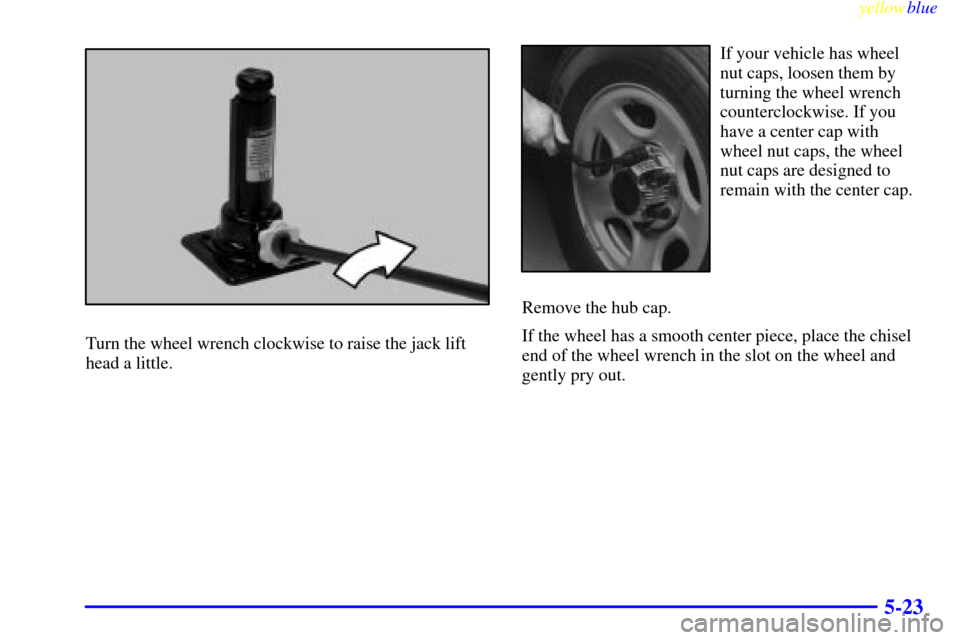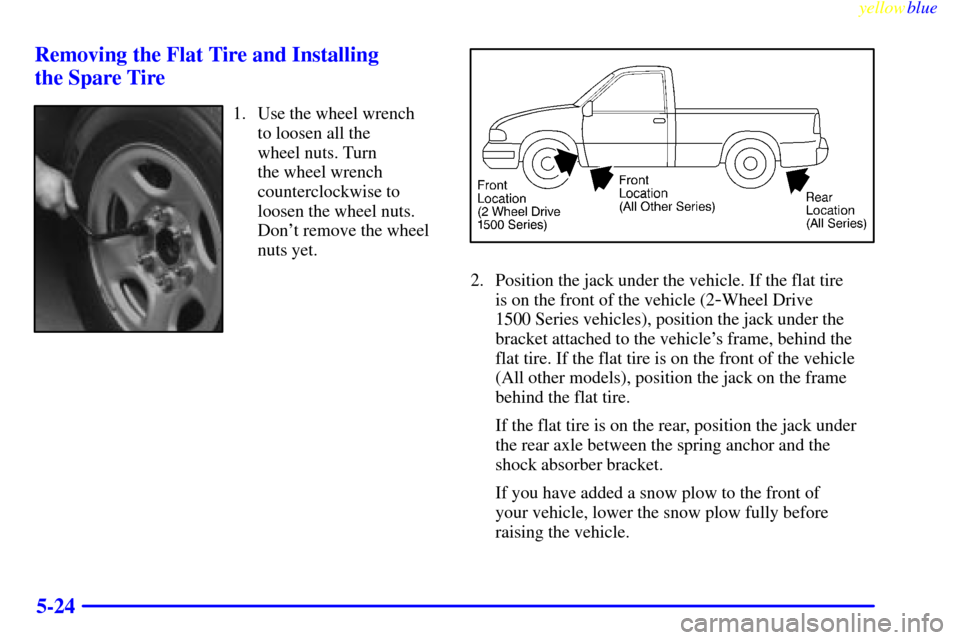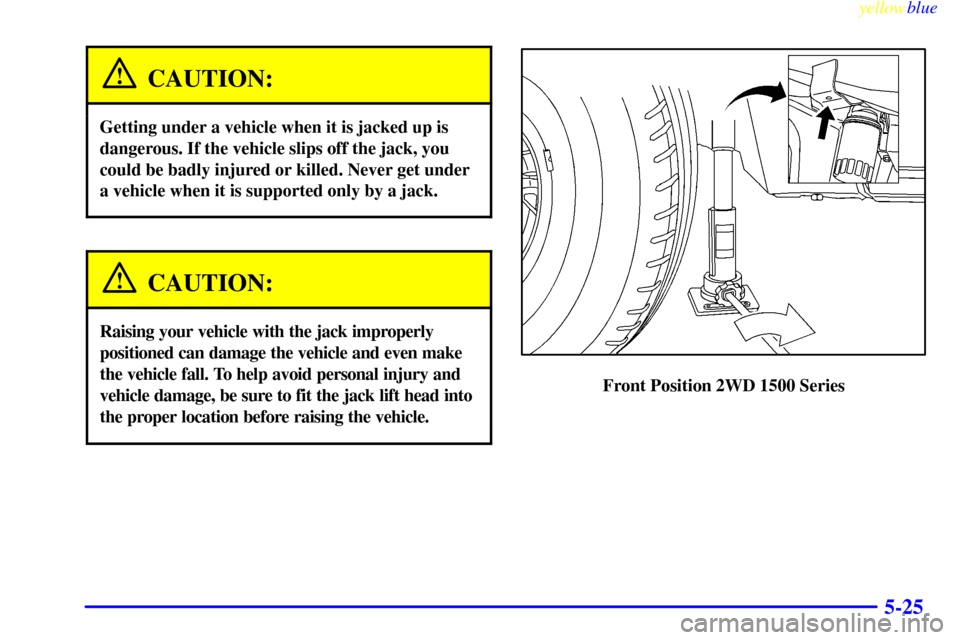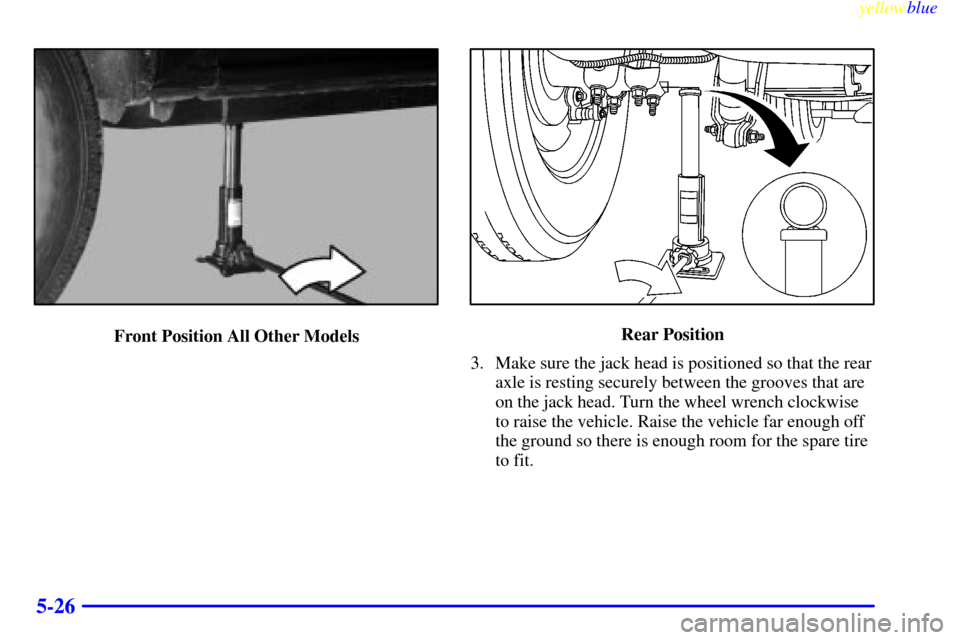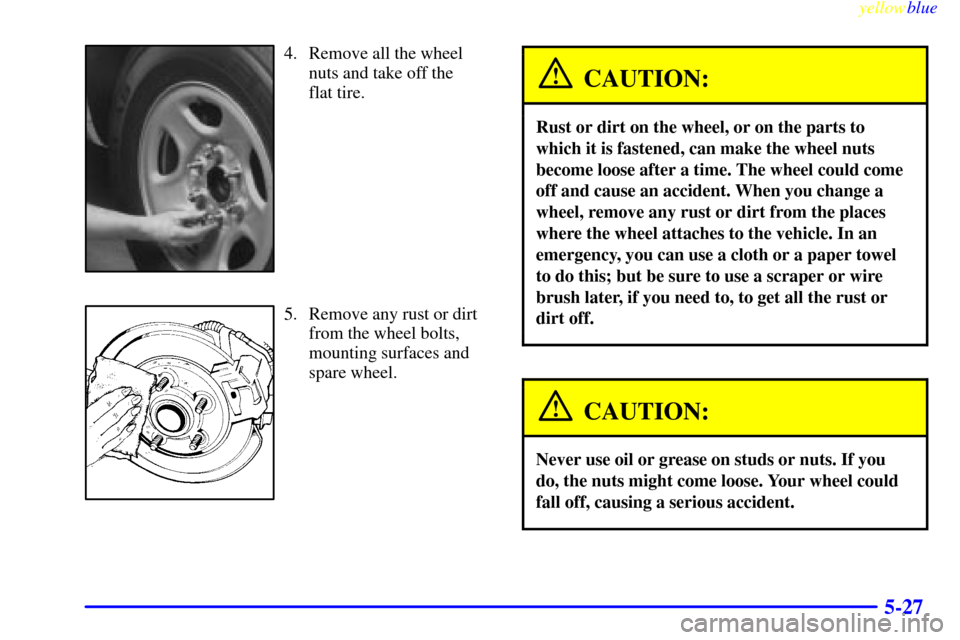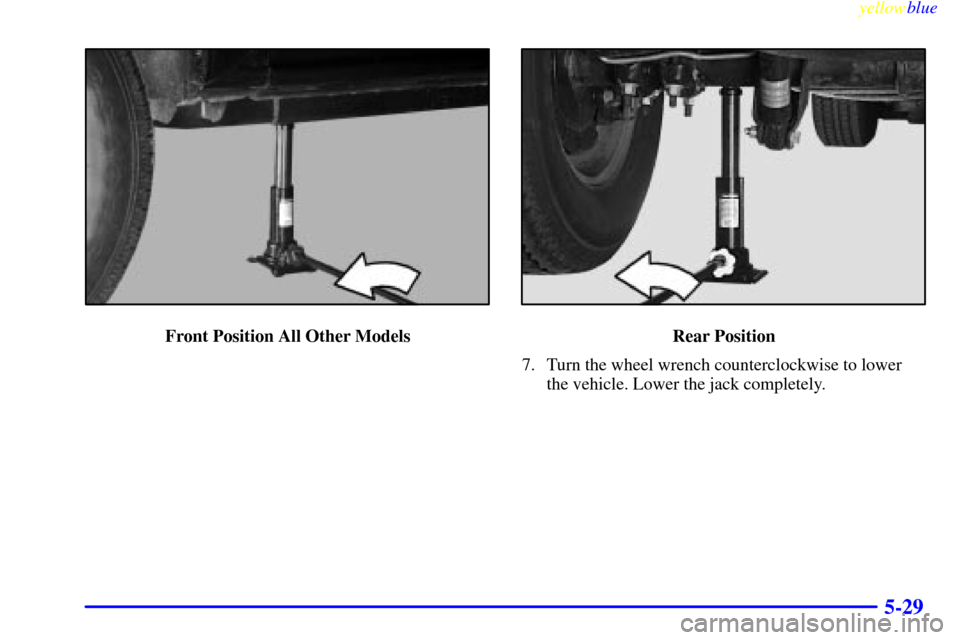CHEVROLET SILVERADO 1999 1.G Owners Manual
SILVERADO 1999 1.G
CHEVROLET
CHEVROLET
https://www.carmanualsonline.info/img/24/8270/w960_8270-0.png
CHEVROLET SILVERADO 1999 1.G Owners Manual
Trending: start stop button, wiring, radiator cap, torque, automatic transmission fluid, washer fluid, tire type
Page 281 of 432

yellowblue
5-21
You'll use the jack handle and the wheel wrench to
remove the underbody
-mounted spare tire.
A. Hoist Assembly
B. Wheel Wrench
C. Extensions
D. Hoist Shaft
E. Valve Stem,
Pointed Down
F. Spare TireG. Tire Retainer
H. Hoist Cable
I. Hoist Lock
J. Hoist Shaft
Access Hole
K. Hoist EndFollow these instructions to lower the spare tire:
1. If the vehicle is equipped with a hoist lock, open the
spare tire lock cover on the bumper and use the
ignition key to remove the lock.
2. Assemble the wheel wrench and the two jack handle
extensions as shown. Insert the hoist end of the
extension through the hole in the rear bumper. Be
sure the hoist end of the extension connects into the
hoist shaft.
3. Turn the wheel wrench counterclockwise to lower
the spare tire to the ground. Continue to turn the
wheel wrench until the spare tire can be pulled out
from under the vehicle. The wheel wrench has a
hook feature that allows you to pull the hoist cable
towards you, to assist you in reaching the spare tire.
4. When the tire has been lowered, tilt the retainer at
the end of the cable so it can be pulled up through
the wheel opening.
5. Put the spare tire near the flat tire.
Page 282 of 432
yellowblue
5-22
The tools you'll be using include the bottle jack (A), the
wheel blocks (B), the jack handle (C), the jack handle
extensions (D), and the wheel wrench (E).
If the flat tire is on the rear of the vehicle, you'll need to
use both jack handle extensions.Attach the wheel wrench to the jack handle extensions
(as needed). Attach the jack handle to the jack.
Page 283 of 432
yellowblue
5-23
Turn the wheel wrench clockwise to raise the jack lift
head a little.
If your vehicle has wheel
nut caps, loosen them by
turning the wheel wrench
counterclockwise. If you
have a center cap with
wheel nut caps, the wheel
nut caps are designed to
remain with the center cap.
Remove the hub cap.
If the wheel has a smooth center piece, place the chisel
end of the wheel wrench in the slot on the wheel and
gently pry out.
Page 284 of 432
yellowblue
5-24 Removing the Flat Tire and Installing
the Spare Tire
1. Use the wheel wrench
to loosen all the
wheel nuts. Turn
the wheel wrench
counterclockwise to
loosen the wheel nuts.
Don't remove the wheel
nuts yet.
2. Position the jack under the vehicle. If the flat tire
is on the front of the vehicle (2
-Wheel Drive
1500 Series vehicles), position the jack under the
bracket attached to the vehicle's frame, behind the
flat tire. If the flat tire is on the front of the vehicle
(All other models), position the jack on the frame
behind the flat tire.
If the flat tire is on the rear, position the jack under
the rear axle between the spring anchor and the
shock absorber bracket.
If you have added a snow plow to the front of
your vehicle, lower the snow plow fully before
raising the vehicle.
Page 285 of 432
yellowblue
5-25
CAUTION:
Getting under a vehicle when it is jacked up is
dangerous. If the vehicle slips off the jack, you
could be badly injured or killed. Never get under
a vehicle when it is supported only by a jack.
CAUTION:
Raising your vehicle with the jack improperly
positioned can damage the vehicle and even make
the vehicle fall. To help avoid personal injury and
vehicle damage, be sure to fit the jack lift head into
the proper location before raising the vehicle.
Front Position 2WD 1500 Series
Page 286 of 432
yellowblue
5-26
Front Position All Other ModelsRear Position
3. Make sure the jack head is positioned so that the rear
axle is resting securely between the grooves that are
on the jack head. Turn the wheel wrench clockwise
to raise the vehicle. Raise the vehicle far enough off
the ground so there is enough room for the spare tire
to fit.
Page 287 of 432
yellowblue
5-27
4. Remove all the wheel
nuts and take off the
flat tire.
5. Remove any rust or dirt
from the wheel bolts,
mounting surfaces and
spare wheel.
CAUTION:
Rust or dirt on the wheel, or on the parts to
which it is fastened, can make the wheel nuts
become loose after a time. The wheel could come
off and cause an accident. When you change a
wheel, remove any rust or dirt from the places
where the wheel attaches to the vehicle. In an
emergency, you can use a cloth or a paper towel
to do this; but be sure to use a scraper or wire
brush later, if you need to, to get all the rust or
dirt off.
CAUTION:
Never use oil or grease on studs or nuts. If you
do, the nuts might come loose. Your wheel could
fall off, causing a serious accident.
Page 288 of 432
yellowblue
5-28
6. After mounting the
spare, replace the wheel
nuts with the rounded
end of the nuts toward
the wheel. Tighten each
wheel nut by hand using
the wheel wrench until
the wheel is held against
the hub.
Front Position 2WD 1500 Series
Page 289 of 432
yellowblue
5-29
Front Position All Other ModelsRear Position
7. Turn the wheel wrench counterclockwise to lower
the vehicle. Lower the jack completely.
Page 290 of 432
yellowblue
5-30
8. Tighten the nuts firmly in a crisscross sequence as
shown by turning the wheel wrench clockwise.
CAUTION:
Incorrect wheel nuts or improperly tightened
wheel nuts can cause the wheel to become loose
and even come off. This could lead to an accident.
Be sure to use the correct wheel nuts. If you have
to replace them, be sure to get new GM original
equipment wheel nuts.
Stop somewhere as soon as you can and have the
nuts tightened with a torque wrench to the
proper torque. See ªCapacities and
Specificationsº in the Index.
NOTICE:
Improperly tightened wheel nuts can lead to
brake pulsation and rotor damage. To avoid
expensive brake repairs, evenly tighten the wheel
nuts in the proper sequence and to the proper
torque specification.
Trending: check oil, towing capacity, key, radio antenna, brake sensor, fuel tank capacity, battery replacement


